air filter FIAT TALENTO 2017 Owner handbook (in English)
[x] Cancel search | Manufacturer: FIAT, Model Year: 2017, Model line: TALENTO, Model: FIAT TALENTO 2017Pages: 228, PDF Size: 4.47 MB
Page 34 of 228

ACTIVATION AND
DEACTIVATION OF THE
SYSTEM
Press button 1 fig. 65 to deactivate the
function. The dedicated message will
appear on the instrument panel and the
warning light 2 fig. 65 on the button will
turn on.
Pressing again will reactivate the
system. The appropriate message will
appear on the instrument panel and the
warning light 2 on the button 1 will turn
off.
The system re-activates automatically
whenever the vehicle is voluntarily
restarted (refer to the "Starting the
engine” paragraph in the “Starting and
driving” chapter).
NOTES: With the engine in stand-by,
press button 1: the engine restarts
automatically.Special cases
For vehicles with an electronic key,
with the system activated, engine off
(traffic jam, stopping at a red light, etc.),
if the driver rises up from his seat or
unbuckles his seat belt, the contact is
disengaged. To restart the Start&Stop
system, press the ignition button (see
"Starter switch” paragraph in the
“Knowing your vehicle” chapter).
In case the engine stops, if the
system is activated, press down hard
on the clutch pedal to restart it.
MISSED ENGINE
STOPPING CONDITIONS
Depending on the vehicle, some
conditions stop the system from
applying the stand-by engine,
specifically:
reverse is in gear;
the bonnet is not locked;
for vehicles with an electronic key,
the driver's door is not closed;
for vehicles with an electronic key,
the driver's seat belt is not fastened;
the outside temperature is too low or
too high (lower than 0°C or over 30°C);
the battery not sufficiently charged;
there is too much difference between
the inside vehicle temperature and that
set by the automatic climate control;
the MAX DEF function is activated
(refer to the "Air conditioning"paragraph in the "Knowing your vehicle”
chapter);
the engine coolant liquid temperature
is not sufficient;
the anti-particulate filter automatic
regeneration is underway;
Or:
the instrument panel warning light
turns on to indicate that the engine
cannot be put in standby.
NOTES:To refuel, the engine must be
turned off (and not in stand-by): you
must stop the engine (refer to the
"Starting the engine” paragraph in the
“Starting and driving” chapter):
RESTARTING
CONDITIONS
In some cases, the engine can restart
without any intervention to guarantee
safety and ideal comfort. This can be
confirmed when:
the outside temperature is too low or
too high (lower than 0°C or over 30°C);
the MAX DEF function is activated
(refer to the "Air conditioning"
paragraph in the "Knowing your vehicle”
chapter);
the battery not sufficiently charged;
the vehicle speed is higher than
5 km/h (going downhill, etc.);
repeated pressure on the brake
pedal or need to use the braking
system;
65T36535
32
KNOWING YOUR VEHICLE
Page 47 of 228
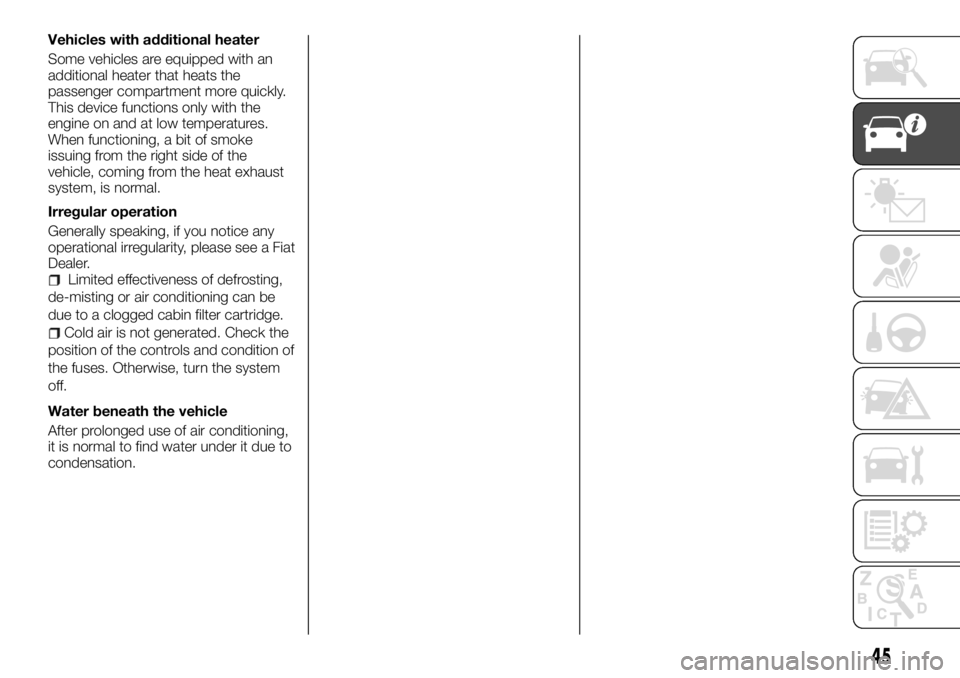
Vehicles with additional heater
Some vehicles are equipped with an
additional heater that heats the
passenger compartment more quickly.
This device functions only with the
engine on and at low temperatures.
When functioning, a bit of smoke
issuing from the right side of the
vehicle, coming from the heat exhaust
system, is normal.
Irregular operation
Generally speaking, if you notice any
operational irregularity, please see a Fiat
Dealer.
Limited effectiveness of defrosting,
de-misting or air conditioning can be
due to a clogged cabin filter cartridge.
Cold air is not generated. Check the
position of the controls and condition of
the fuses. Otherwise, turn the system
off.
Water beneath the vehicle
After prolonged use of air conditioning,
it is normal to find water under it due to
condensation.
45
Page 73 of 228
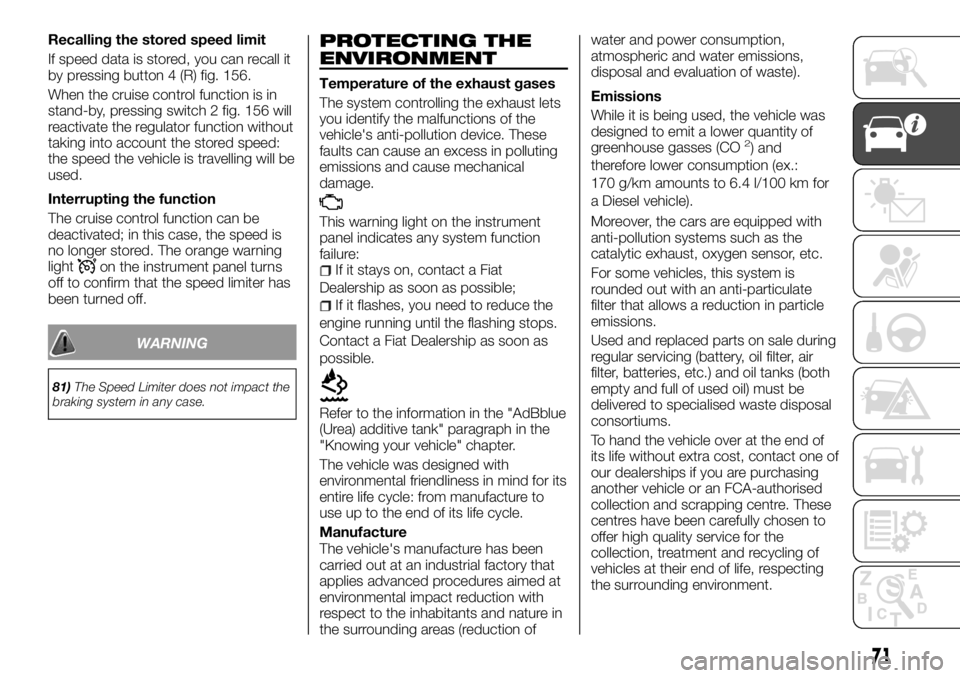
Recalling the stored speed limit
If speed data is stored, you can recall it
by pressing button 4 (R) fig. 156.
When the cruise control function is in
stand-by, pressing switch 2 fig. 156 will
reactivate the regulator function without
taking into account the stored speed:
the speed the vehicle is travelling will be
used.
Interrupting the function
The cruise control function can be
deactivated; in this case, the speed is
no longer stored. The orange warning
light
on the instrument panel turns
off to confirm that the speed limiter has
been turned off.
WARNING
81)The Speed Limiter does not impact the
braking system in any case.
PROTECTING THE
ENVIRONMENT
Temperature of the exhaust gases
The system controlling the exhaust lets
you identify the malfunctions of the
vehicle's anti-pollution device. These
faults can cause an excess in polluting
emissions and cause mechanical
damage.
This warning light on the instrument
panel indicates any system function
failure:
If it stays on, contact a Fiat
Dealership as soon as possible;
If it flashes, you need to reduce the
engine running until the flashing stops.
Contact a Fiat Dealership as soon as
possible.
Refer to the information in the "AdBblue
(Urea) additive tank" paragraph in the
"Knowing your vehicle" chapter.
The vehicle was designed with
environmental friendliness in mind for its
entire life cycle: from manufacture to
use up to the end of its life cycle.
Manufacture
The vehicle's manufacture has been
carried out at an industrial factory that
applies advanced procedures aimed at
environmental impact reduction with
respect to the inhabitants and nature in
the surrounding areas (reduction ofwater and power consumption,
atmospheric and water emissions,
disposal and evaluation of waste).
Emissions
While it is being used, the vehicle was
designed to emit a lower quantity of
greenhouse gasses (CO
2) and
therefore lower consumption (ex.:
170 g/km amounts to 6.4 l/100 km for
a Diesel vehicle).
Moreover, the cars are equipped with
anti-pollution systems such as the
catalytic exhaust, oxygen sensor, etc.
For some vehicles, this system is
rounded out with an anti-particulate
filter that allows a reduction in particle
emissions.
Used and replaced parts on sale during
regular servicing (battery, oil filter, air
filter, batteries, etc.) and oil tanks (both
empty and full of used oil) must be
delivered to specialised waste disposal
consortiums.
To hand the vehicle over at the end of
its life without extra cost, contact one of
our dealerships if you are purchasing
another vehicle or an FCA-authorised
collection and scrapping centre. These
centres have been carefully chosen to
offer high quality service for the
collection, treatment and recycling of
vehicles at their end of life, respecting
the surrounding environment.
71
Page 74 of 228
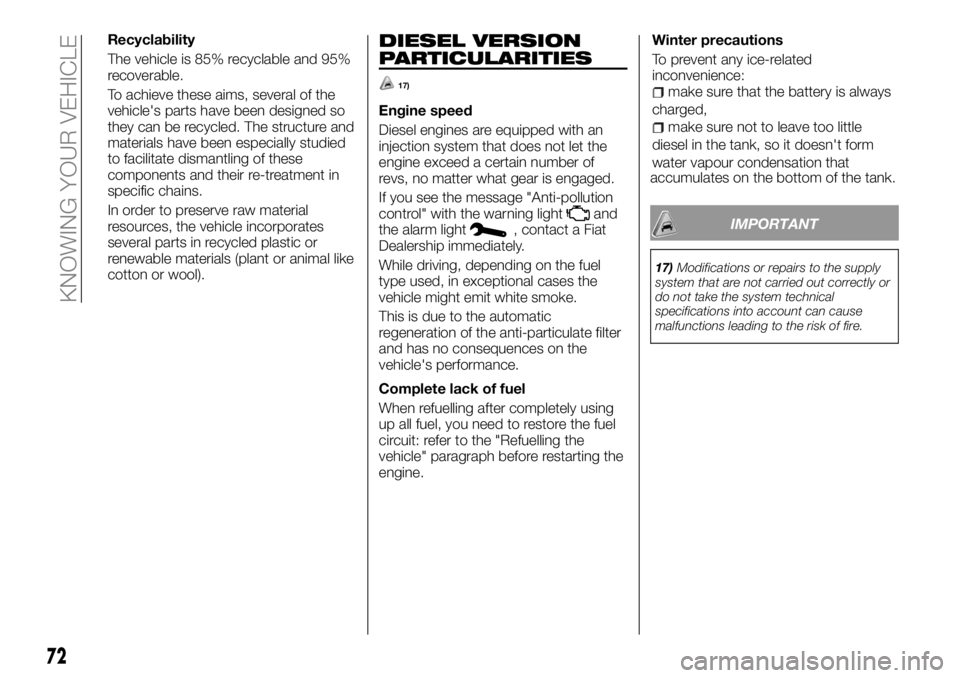
Recyclability
The vehicle is 85% recyclable and 95%
recoverable.
To achieve these aims, several of the
vehicle's parts have been designed so
they can be recycled. The structure and
materials have been especially studied
to facilitate dismantling of these
components and their re-treatment in
specific chains.
In order to preserve raw material
resources, the vehicle incorporates
several parts in recycled plastic or
renewable materials (plant or animal like
cotton or wool).DIESEL VERSION
PARTICULARITIES
17)
Engine speed
Diesel engines are equipped with an
injection system that does not let the
engine exceed a certain number of
revs, no matter what gear is engaged.
If you see the message "Anti-pollution
control" with the warning light
and
the alarm light, contact a Fiat
Dealership immediately.
While driving, depending on the fuel
type used, in exceptional cases the
vehicle might emit white smoke.
This is due to the automatic
regeneration of the anti-particulate filter
and has no consequences on the
vehicle's performance.
Complete lack of fuel
When refuelling after completely using
up all fuel, you need to restore the fuel
circuit: refer to the "Refuelling the
vehicle" paragraph before restarting the
engine.Winter precautions
To prevent any ice-related
inconvenience:
make sure that the battery is always
charged,
make sure not to leave too little
diesel in the tank, so it doesn't form
water vapour condensation that
accumulates on the bottom of the tank.
IMPORTANT
17)Modifications or repairs to the supply
system that are not carried out correctly or
do not take the system technical
specifications into account can cause
malfunctions leading to the risk of fire.
72
KNOWING YOUR VEHICLE
Page 164 of 228
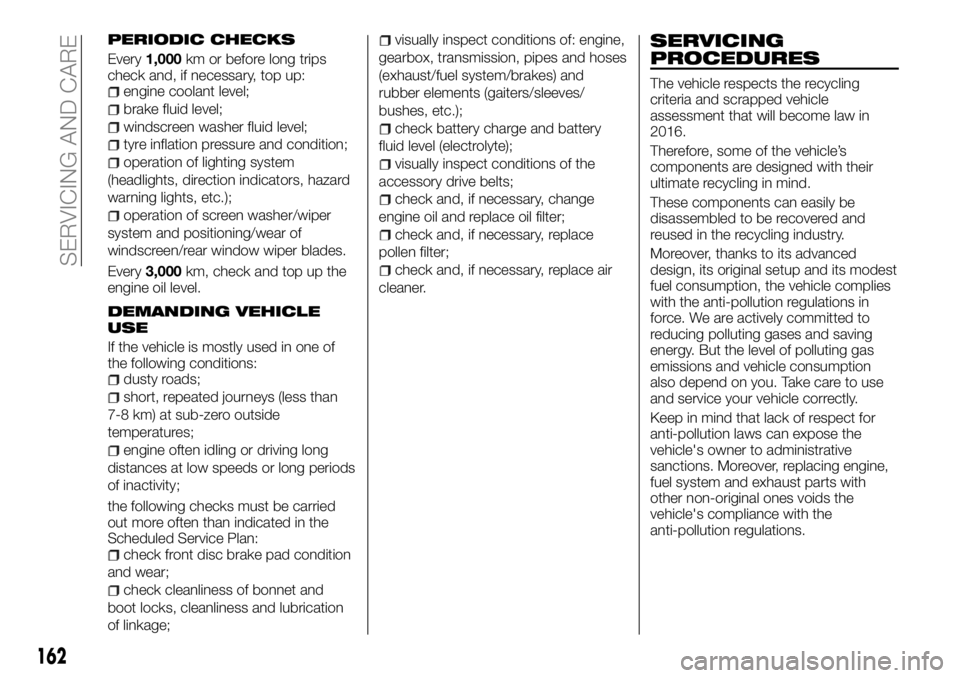
PERIODIC CHECKS
Every1,000km or before long trips
check and, if necessary, top up:
engine coolant level;
brake fluid level;
windscreen washer fluid level;
tyre inflation pressure and condition;
operation of lighting system
(headlights, direction indicators, hazard
warning lights, etc.);
operation of screen washer/wiper
system and positioning/wear of
windscreen/rear window wiper blades.
Every3,000km, check and top up the
engine oil level.
DEMANDING VEHICLE
USE
If the vehicle is mostly used in one of
the following conditions:
dusty roads;
short, repeated journeys (less than
7-8 km) at sub-zero outside
temperatures;
engine often idling or driving long
distances at low speeds or long periods
of inactivity;
the following checks must be carried
out more often than indicated in the
Scheduled Service Plan:
check front disc brake pad condition
and wear;
check cleanliness of bonnet and
boot locks, cleanliness and lubrication
of linkage;
visually inspect conditions of: engine,
gearbox, transmission, pipes and hoses
(exhaust/fuel system/brakes) and
rubber elements (gaiters/sleeves/
bushes, etc.);
check battery charge and battery
fluid level (electrolyte);
visually inspect conditions of the
accessory drive belts;
check and, if necessary, change
engine oil and replace oil filter;
check and, if necessary, replace
pollen filter;
check and, if necessary, replace air
cleaner.
SERVICING
PROCEDURES
The vehicle respects the recycling
criteria and scrapped vehicle
assessment that will become law in
2016.
Therefore, some of the vehicle’s
components are designed with their
ultimate recycling in mind.
These components can easily be
disassembled to be recovered and
reused in the recycling industry.
Moreover, thanks to its advanced
design, its original setup and its modest
fuel consumption, the vehicle complies
with the anti-pollution regulations in
force. We are actively committed to
reducing polluting gases and saving
energy. But the level of polluting gas
emissions and vehicle consumption
also depend on you. Take care to use
and service your vehicle correctly.
Keep in mind that lack of respect for
anti-pollution laws can expose the
vehicle's owner to administrative
sanctions. Moreover, replacing engine,
fuel system and exhaust parts with
other non-original ones voids the
vehicle's compliance with the
anti-pollution regulations.
162
SERVICING AND CARE
Page 165 of 228
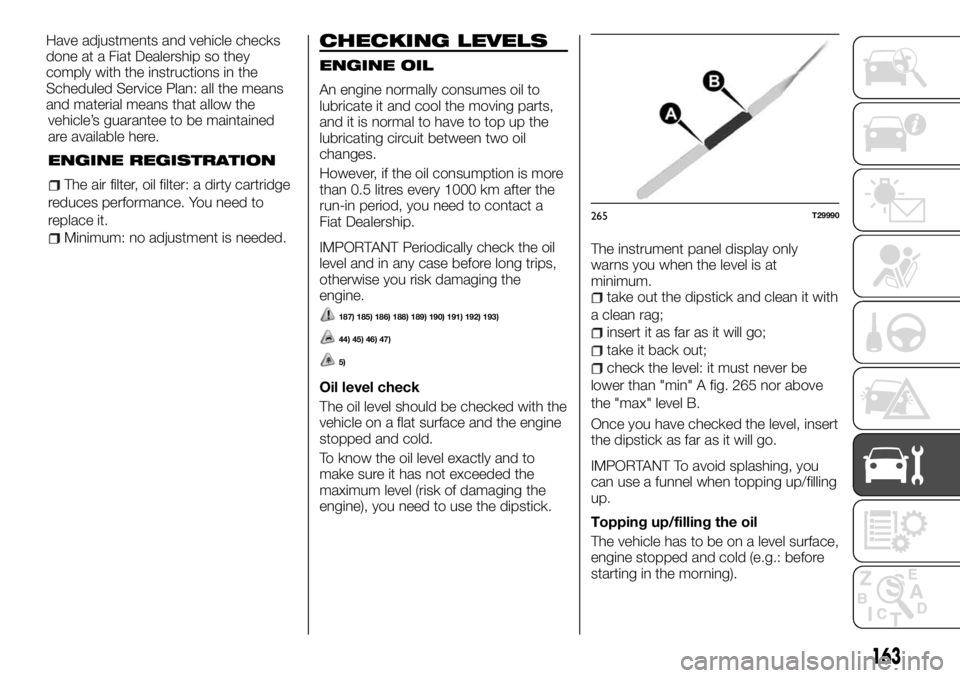
vehicle’s guarantee to be maintained
are available here.
ENGINE REGISTRATION
The air filter, oil filter: a dirty cartridge
reduces performance. You need to
replace it.
Minimum: no adjustment is needed.
CHECKING LEVELS
ENGINE OIL
An engine normally consumes oil to
lubricate it and cool the moving parts,
and it is normal to have to top up the
lubricating circuit between two oil
changes.
However, if the oil consumption is more
than 0.5 litres every 1000 km after the
run-in period, you need to contact a
Fiat Dealership.
IMPORTANT Periodically check the oil
level and in any case before long trips,
otherwise you risk damaging the
engine.
187) 185) 186) 188) 189) 190) 191) 192) 193)
44) 45) 46) 47)
5)
Oil level check
The oil level should be checked with the
vehicle on a flat surface and the engine
stopped and cold.
To know the oil level exactly and to
make sure it has not exceeded the
maximum level (risk of damaging the
engine), you need to use the dipstick.The instrument panel display only
warns you when the level is at
minimum.
take out the dipstick and clean it with
a clean rag;
insert it as far as it will go;
take it back out;
check the level: it must never be
lower than "min" A fig. 265 nor above
the "max" level B.
Once you have checked the level, insert
the dipstick as far as it will go.
IMPORTANT To avoid splashing, you
can use a funnel when topping up/filling
up.
Topping up/filling the oil
The vehicle has to be on a level surface,
engine stopped and cold (e.g.: before
starting in the morning).
265T29990
163
Have adjustments and vehicle checks
done at a Fiat Dealership so they
comply with the instructions in the
Scheduled Service Plan: all the means
and material means that allow the
Page 168 of 228
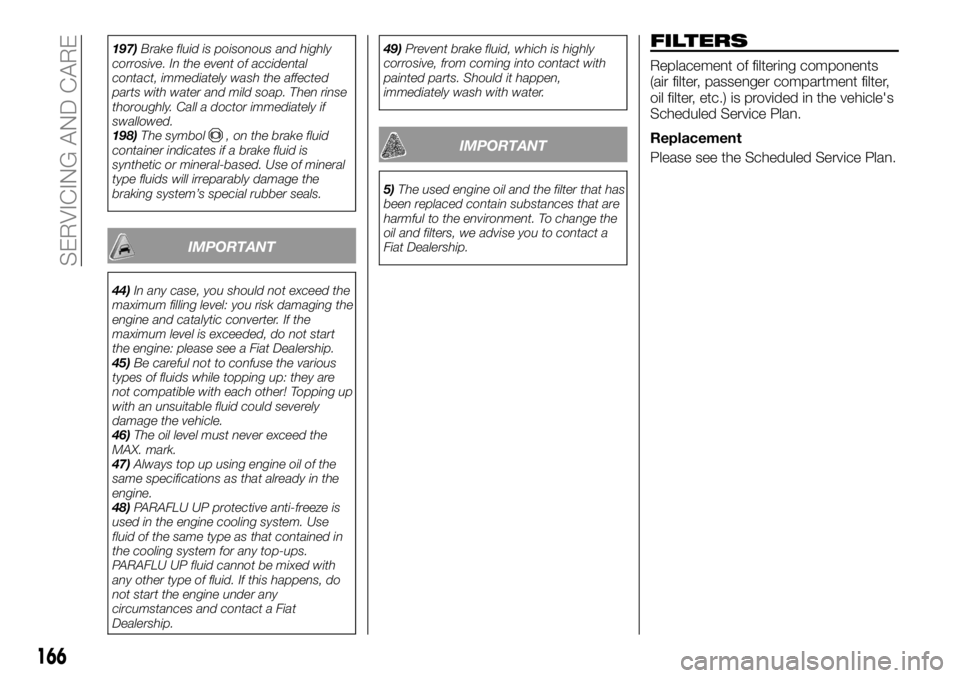
197)Brake fluid is poisonous and highly
corrosive. In the event of accidental
contact, immediately wash the affected
parts with water and mild soap. Then rinse
thoroughly. Call a doctor immediately if
swallowed.
198)The symbol
, on the brake fluid
container indicates if a brake fluid is
synthetic or mineral-based. Use of mineral
type fluids will irreparably damage the
braking system’s special rubber seals.
IMPORTANT
44)In any case, you should not exceed the
maximum filling level: you risk damaging the
engine and catalytic converter. If the
maximum level is exceeded, do not start
the engine: please see a Fiat Dealership.
45)Be careful not to confuse the various
types of fluids while topping up: they are
not compatible with each other! Topping up
with an unsuitable fluid could severely
damage the vehicle.
46)The oil level must never exceed the
MAX. mark.
47)Always top up using engine oil of the
same specifications as that already in the
engine.
48)PARAFLU UP protective anti-freeze is
used in the engine cooling system. Use
fluid of the same type as that contained in
the cooling system for any top-ups.
PARAFLU UP fluid cannot be mixed with
any other type of fluid. If this happens, do
not start the engine under any
circumstances and contact a Fiat
Dealership.49)Prevent brake fluid, which is highly
corrosive, from coming into contact with
painted parts. Should it happen,
immediately wash with water.
IMPORTANT
5)The used engine oil and the filter that has
been replaced contain substances that are
harmful to the environment. To change the
oil and filters, we advise you to contact a
Fiat Dealership.
FILTERS
Replacement of filtering components
(air filter, passenger compartment filter,
oil filter, etc.) is provided in the vehicle's
Scheduled Service Plan.
Replacement
Please see the Scheduled Service Plan.
166
SERVICING AND CARE
Page 180 of 228
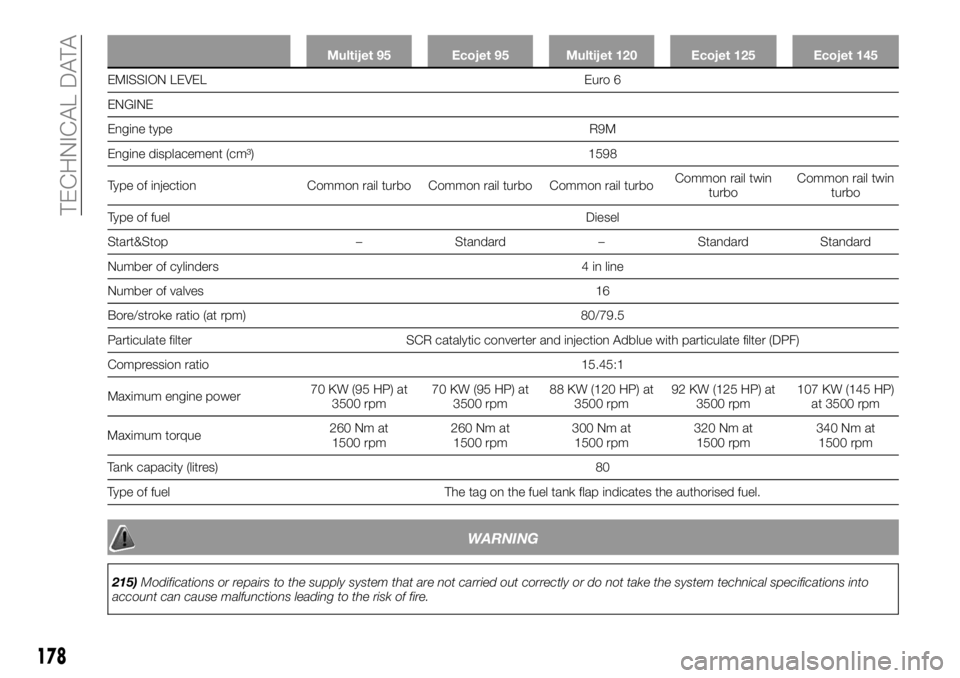
Multijet 95 Ecojet 95 Multijet 120 Ecojet 125 Ecojet 145
EMISSION LEVEL Euro 6
ENGINE
Engine
typeR9M
Engine displacement (cm³) 1598
Type of injection Common rail turbo Common rail turbo Common rail turboCommon rail twin
turboCommon rail twin
turbo
Type of fuelDiesel
Start&Stop – Standard – Standard Standard
Number of cylinders 4 in line
Number of valves 16
Bore/stroke ratio (at rpm) 80/79.5
Particulate filter SCR catalytic converter and injection Adblue with particulate filter (DPF)
Compression ratio 15.45:1
Maximum engine power70 KW (95 HP) at
3500 rpm70 KW (95 HP) at
3500 rpm88 KW (120 HP) at
3500 rpm92 KW (125 HP) at
3500 rpm107 KW (145 HP)
at 3500 rpm
Maximum torque260 Nm at
1500 rpm260 Nm at
1500 rpm300 Nm at
1500 rpm320 Nm at
1500 rpm340 Nm at
1500 rpm
Tank capacity (litres) 80
Type of fuel The tag on the fuel tank flap indicates the authorised fuel.
WARNING
215)Modifications or repairs to the supply system that are not carried out correctly or do not take the system technical specifications into
account can cause malfunctions leading to the risk of fire.
178
TECHNICAL DATA
Page 225 of 228
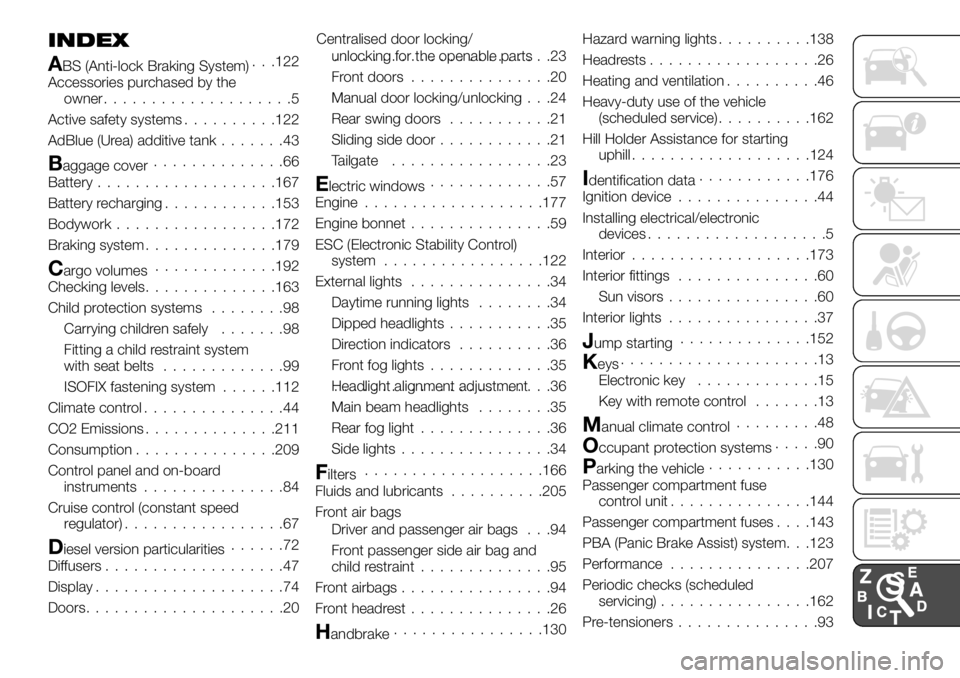
INDEX
ABS (Anti-lock Braking System). . .122
Accessories purchased by the
owner....................5
Active safety systems..........122
AdBlue (Urea) additive tank.......43
Baggage cover..............66
Battery...................167
Battery recharging............153
Bodywork.................172
Braking system..............179
Cargo volumes.............192
Checking levels..............163
Child protection systems........98
Carrying children safely.......98
Fitting a child restraint system
with seat belts.............99
ISOFIX fastening system......112
Climate control...............44
CO2 Emissions..............211
Consumption...............209
Control panel and on-board
instruments...............84
Cruise control (constant speed
regulator).................67
Diesel version particularities......72
Diffusers...................47
Display....................74
Doors.....................20Centralised door locking/
unlocking for the openable parts.......................23
Front doors...............20
Manual door locking/unlocking . . .24
Rear swing doors...........21
Sliding side door............21
Tailgate.................23
Electric windows.............57
Engine...................177
Engine bonnet...............59
ESC (Electronic Stability Control)
system.................122
External lights...............34
Daytime running lights........34
Dipped headlights...........35
Direction indicators..........36
Front fog lights.............35
Headlight alignment adjustment.......................36
Main beam headlights........35
Rear fog light..............36
Side lights................34
Filters...................166
Fluids and lubricants..........205
Front air bags
Driver and passenger air bags . . .94
Front passenger side air bag and
child restraint..............95
Front airbags................94
Front headrest...............26
Handbrake................130Hazard warning lights..........138
Headrests..................26
Heating and ventilation..........46
Heavy-duty use of the vehicle
(scheduled service)..........162
Hill Holder Assistance for starting
uphill...................124
Identification data............176
Ignition device...............44
Installing electrical/electronic
devices...................5
Interior...................173
Interior fittings...............60
Sun visors................60
Interior lights................37
Jump starting..............152
Keys.....................13
Electronic key.............15
Key with remote control.......13
Manual climate control.........48
Occupant protection systems.....90
Parking the vehicle...........130
Passenger compartment fuse
control unit...............144
Passenger compartment fuses. . . .143
PBA (Panic Brake Assist) system. . .123
Performance...............207
Periodic checks (scheduled
servicing)................162
Pre-tensioners...............93